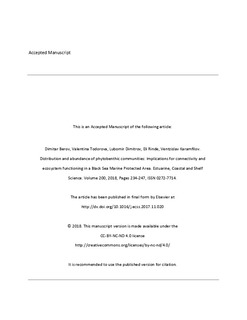| dc.contributor.author | Berov, Dimitar | |
| dc.contributor.author | Todorova, Valentina | |
| dc.contributor.author | Dimitrov, Lubomir | |
| dc.contributor.author | Rinde, Eli | |
| dc.contributor.author | Karamfilov, Ventzislav | |
| dc.date.accessioned | 2019-05-29T08:55:17Z | |
| dc.date.available | 2019-05-29T08:55:17Z | |
| dc.date.created | 2018-07-18T12:32:33Z | |
| dc.date.issued | 2018 | |
| dc.identifier.citation | Estuarine, Coastal and Shelf Science. 2018, 200, 234-247. | nb_NO |
| dc.identifier.issn | 0272-7714 | |
| dc.identifier.uri | http://hdl.handle.net/11250/2599385 | |
| dc.description | Embargo until 14 November 2019 | nb_NO |
| dc.description.abstract | The distribution and abundance of macroalgal communities in a Marine Protected Area (MPA) along the Bulgarian Black Sea coast were mapped and quantified, with particular focus on the previously unstudied P. crispa lower-infralittoral communities on Ostrea edulis biogenic reefs. Data from high resolution geophysical substrate mapping were combined with benthic community observations from georeferenced benthic photographic surveys and sampling. Multivariate analysis identified four distinct assemblages of lower-infralittoral macroalgal communities at depths between 10 and 17 m, dominated by Phyllophora crispa, Apoglossum ruscifoluim, Zanardinia typus and Gelidium spp. Maxent software analysis showed distinct preferences of the identified communities to areas with specific ranges of depth, inclination and curvature, with P. crispa more frequently occurring on vertical oyster biogenic reef structures. By combining production rates from literature, biomass measurements and the produced habitat maps, the highest proportion of primary production and DOC release was shown for the upper infralittoral Cystoseira barbata and Cystoseira bosphorica, followed by the production of the lower-infralittoral macroalgae. The observed distribution of P. crispa within the studied MPA was related to the network of Natura 2000 maritime MPAs along the Bulgarian Black Sea coast, which indicated that the connectivity of the populations of the species within the established network is insufficient within this cell of ecosystem functioning. | nb_NO |
| dc.language.iso | eng | nb_NO |
| dc.publisher | Elsevier | nb_NO |
| dc.rights | Attribution-NonCommercial-NoDerivatives 4.0 Internasjonal | * |
| dc.rights.uri | http://creativecommons.org/licenses/by-nc-nd/4.0/deed.no | * |
| dc.title | Distribution and abundance of phytobenthic communities: Implications for connectivity and ecosystem functioning in a Black Sea Marine Protected Area | nb_NO |
| dc.type | Journal article | nb_NO |
| dc.type | Peer reviewed | nb_NO |
| dc.description.version | acceptedVersion | nb_NO |
| dc.rights.holder | © 2018 Elsevier | nb_NO |
| dc.source.pagenumber | 234-247 | nb_NO |
| dc.source.volume | 200 | nb_NO |
| dc.source.journal | Estuarine, Coastal and Shelf Science | nb_NO |
| dc.identifier.doi | 10.1016/j.ecss.2017.11.020 | |
| dc.identifier.cristin | 1597780 | |
| dc.relation.project | EC/FP7/287844 | nb_NO |
| cristin.unitcode | 7464,20,11,0 | |
| cristin.unitname | Marin biologi | |
| cristin.ispublished | true | |
| cristin.fulltext | postprint | |
| cristin.qualitycode | 1 | |

